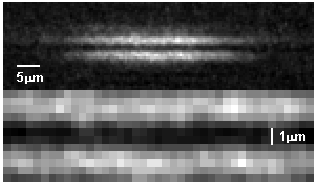Josephson effect in a Bose-Einstein condensate
 The Josephson effect was first discovered in a system of two superconductors separated by a tunneling barrier. In the AC Josephson effect, a constant voltage is applied between the two superconductors. This results in an oscillating tunneling current through the barrier, with a frequency proportional to the applied voltage. Since the proportionality constant involves fundamental constants only, the AC Josephson effect serves as the voltage standard.
The Josephson effect was first discovered in a system of two superconductors separated by a tunneling barrier. In the AC Josephson effect, a constant voltage is applied between the two superconductors. This results in an oscillating tunneling current through the barrier, with a frequency proportional to the applied voltage. Since the proportionality constant involves fundamental constants only, the AC Josephson effect serves as the voltage standard.
Applying a constant current results in the DC Josephson effect. This is a voltage-free current (a supercurrent), which flows through the tunneling barrier, as if the barrier were a superconductor. If the current is too large however, a voltage appears and a transition to the AC Josephson effect occurs. This sharp transition gives a SQUID (superconducting quantum interference device) its excellent sensitivity to magnetic flux.
We made the first observation of both the AC and DC Josephson effects in a Bose-Einstein condensate. This pioneering work opened the door for the currently active area of trying build a SQUID analogue in a Bose-Einstein condensate, which would measure rotation rather than magnetic field.
Related publication
- Levi, S. Lahoud, E., Shomroni, I. & Steinhauer J. The a.c. and d.c. Josephson effects in a Bose-Einstein condensate. Nature 449, 579 (2007).

